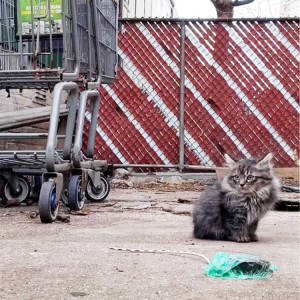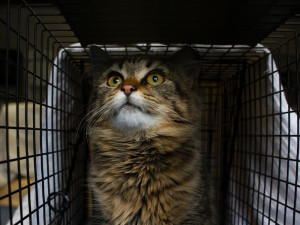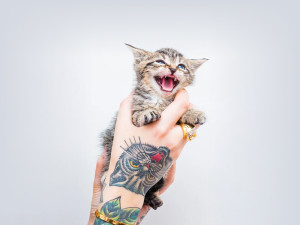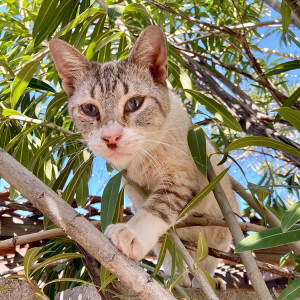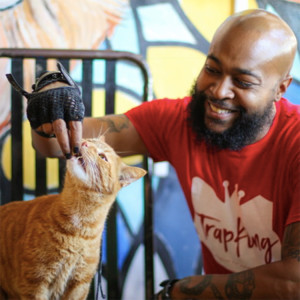How Sassee Walker Is Single-Handedly Saving Brooklyn’s Neediest Cats
“I have the tools to make these cats’ lives better and I use them. I have to.”

share article
It’s noon on a Thursday in mid-May, and Sassee Walker is on her way to feed a colony of feral cats. Their usual feeder is in the hospital, so Walker is stepping in — as she so often does when people and their cats are in need — to make sure the colony is cared for. This morning, she woke up at 5:30 to drive four feral cats to an animal hospital in downtown Brooklyn. It’s an hour drive each way from her home in East New York, and she had to hurry to make sure she was at her computer, ready to start work at 9:00. Walker works remotely for a New York City hospital from 9:00 to 5:00, Monday through Friday, and has a second job every other weekend at a spa out in Far Rockaway.
A Day in the Life of Sassee Cats
Once she logs off for the day, she will need to feed her own colonies, pick up the cats she dropped at the hospital this morning, check the traps in her neighborhood for new cats, and care for the caged, feral cats she has at home. Yesterday, she didn’t make it back to her apartment until midnight, and she can’t be sure what time she’ll finish up tonight. “My day is always long,” she tells The Wildest. “But the good thing is, I sleep well. I could fall asleep standing up.”
Walker got her 501c3 certification earlier this year — making her rescue, Sassee Catsopens in a new tab, an official charitable, tax-exempt organization — but she started her rescue work over a decade ago. “A lot of people pushed me to get certified, but I was already so busy taking care of the cats, and a nonprofit is a lot of work, so I wasn’t really interested,” she says. “It does help you get more donations, which is great, but I haven’t had time yet to apply for any grants because of how busy I am.”
Walker, 53, operates her rescue out of her two-bedroom apartment in the Brownsville neighborhood of Brooklyn, where she usually has around five (or as many as 14) trapped and caged cats in addition to her own cats: Mama Cat, Bernard, Rebecca, and Lecka. It’s a tight squeeze, and it comes with its fair share of problems: She’s constantly having to flea-bomb the place to keep it free of infestations and avoid being a nuisance to her neighbors, and she’s tight-lipped about exactly how many litter boxes she has scattered around the house. (“It’s a lot,” she says.) She used to have access to a basement where a fellow cat rescuer allowed her to keep the feral cats who are at the heart of her TNRopens in a new tab (trap, neuter, return) work, but when her friend retired and left the city, Walker was forced to bring the cats into her own home, at least until she can find a more suitable space.
How Sassee Cats Came to Be
Walker grew up in Brownsville public housing with her mother and little brother, and it was there that she first became interested in rescue work. “It’s a really rough neighborhood and people are really tough on their animals,” she says. “But we would bring in and help the ones we could, so I always grew up loving that.”
She left Brownsville for Queens when she had her daughter — wanting to raise her in a gentler environment — but moved back to save money when her daughter was a teenager. After her daughter moved out, Walker started volunteering at the Animal Care Centers of New Yorkopens in a new tab (ACC), where she felt heartbroken watching all the animals be brought in for surrender. She wanted to do more, but didn’t think she had the time and didn’t know where to even start.
Then, one day, as she was walking around her neighborhood, she came across a feral momma cat with a litter of young kittens. She took the kittens to ACC to be neutered and adopted, but just two months later, the momma cat was pregnant again. The kittens were born shortly after, and a few months later their mother led them to a different part of Brownsville, taught them how to hunt, and left them to fend for themselves. “Every time she would have a new litter, she would just sort of abandon the old one,” Walker says. “I looked at these kittens, who I could tell were all females, because of their coloring, and I just thought, Something has to be done or this is going to be a disaster!”
A woman she worked with, named Raquel, offered to help her with the feral cats in her area, but only if Walker took a TNR class first. “I thought that was mean, at first, making me take a class before she would help me, but I understand why she did it, and now I tell other people the same thing,” she says. The class taught Walker the importance of TNR work for controlling the feral cat population and gave her the skills she needed to do the work herself. After the class, Walker rented cages from the ASPCA and recruited family members to help her set up traps throughout the neighborhood. She caught 28 cats her first time out, and Raquel told her she was a natural.
The Realities of the Work
“It is difficult, though,” Walker says. “I could be doing other things. But I feel like my community is a reflection of me, and if I ignore what’s going on, I’m part of the problem. I’ve never really been one to complain, though. I’m an action person. This is what I choose to do. I have the tools to make these cats’ lives better and I use them. I have to.”
It’s lonely work, and it can be harrowing. A couple of weeks after our interview, Walker sent a text message after a particularly difficult day. She said she’d managed to rescue a kitten who needed to have their leg and tail amputated, but couldn’t manage to trap the kitten’s mother or the eight males following her around, keeping her perpetually pregnant. The cats weren’t interested in any of the five different baits she left out for them and eventually, she had to use the kitten to lure the mother into a trap and then use the mother to lure the males into traps of their own.
The males, in particular, were in terrible shape and needed extensive medical intervention, which left Walker with a vet bill of $3,000. The clinic at the Brooklyn Cat Cafeopens in a new tab, where the cats were treated, is taking up a collection to pay the fees and will not be charging Walker personally, but this is not always possible. Indeed, the vast majority of Walker’s otherwise disposable income is spent on supplies and care for her cats. She says she doesn’t mind spending her own money, but it is not sustainable.
The Financial Realities of the Work
Part of the reason Wilson got her 501c3 certification was because doing so allowed her to get a one-time grant of $10,000 to help her with her rescue work. The money was a huge relief and allowed her to do things like get new tires for the 2002 Toyota Camry she uses to shuttle cats around the city — “I only use the car for rescuing cats,” she says, “If I need to do personal stuff, I take the train.” — but that money is running out fast. “I have one lady who donates $30 every month, which is so sweet, and then I have maybe five other people who donate [when they can],” she says. “I couldn’t do what I do without them.” Still, she needs more.
Walker operates out of her home for now, but even so, there are a lot of expenses. She goes to Costco three times every month for cat food for her colonies, her friends’ colonies, and the trapped cats in her care. She gets cat litter from her friend and mentor, Mary Tschinkel, of Friendly Ferals Inc.opens in a new tab, but she still has to buy her own from time to time and is thus a big fan of Dr. Elsey’s for its low price, odor control, and solid clumping ability, a godsend in a house brimming with so many cats. Brooklyn Cat Cafeopens in a new tab holds appointments for her in their clinic every week and donates a lot of spay/neuter and medical services, but they can’t cover everything. Brooklyn Animal Actionopens in a new tab helps her find fosters and homes for a lot of her friendlier cats, and Flatbush Catsopens in a new tab often shouts her out on social media to help her get donations.
“There is just a small percentage of us [doing this work] who are not white, and we don’t really get funded,” Walker says. “Like, for me, if I put up a post asking for money, I’m lucky if I get $300 or $500. But I know [white] people who will put up the same post and get thousands in a matter of hours.”
What Sassee Cats Needs Right Now
Securing donations from within her own demographic is difficult as well. “A lot of Black people are not [interested in] animal welfare,” she says. “No shame! It’s just the reality of the situation. A lot of them are not educated on why you shouldn’t put animals out on the street and don’t have access to spay/neuter services or don’t know where to get them.”
This is especially true in her own neighborhood as well as other economically disadvantaged areas, which are often lacking in basic human services, let alone animal services, and where the residents are too busy trying to survive to devote their time and energy to the wellbeing of the local feral pet population.
“What I really need are volunteers,” Walker says. “There’s just so much work to do. Even just the picking up and dropping off of the cats. It’s hard trying to be everywhere at once and it is burning me out. I have one guy helping me [regularly] and he is great, but I would love more. I need fosters, too, to help socialize the cats, so I can rehomeopens in a new tab them. And then my third priority would be money.”
Still, money is important, and if you want to help Sassee in her work and are unable to volunteer your time, donations are the next best thing. “I would love to see more people helping fill the needs in these communities,” she says. “Do something. That’s my message. Do something. Educate yourself and help. And love each other.”
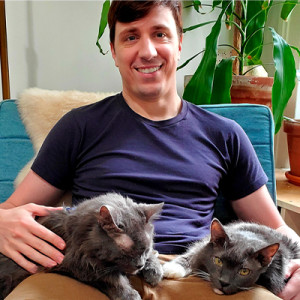
Charles Manning
Charles Manning is an actor, writer, and fashion/media consultant living in New York City with his two cats, Pumpkin and Bear. Follow him on Instagram @charlesemanningopens in a new tab.
Related articles
![a small kitten outside beside a shopping cart]() opens in a new tab
opens in a new tabA New Flatbush Cats Clinic Is Bringing Affordable Care to Brooklyn
Brooklyn pets and parents can expect their new neighbor to arrive this summer.
![A fluffy red-brown cat in a crate]() opens in a new tab
opens in a new tabHow Flatbush Cats Is Saving Brooklyn’s Strays
Ad agency strategist Will Zweigart founded a nonprofit to tackle the neighborhood’s street cat epidemic.
![A hand holding a kitten with a cat tattooed at the hand.]() opens in a new tab
opens in a new tabHeads Up: It’s Officially “Kitten Season”
Hannah Shaw, aka Kitten Lady, on how you can care for orphaned kittens this spring.
![A cat with blue eyes standing before a door entrance.]() opens in a new tab
opens in a new tabHow TNR Is Helping Outdoor Cats
Trap-Neuter-Return is the most humane way to keep stray cat populations in check. Here’s how it works.
![A cat peeking down from a tree.]() opens in a new tab
opens in a new tabMeet This Colony of Accidentally Insta-Famous Cats
How one cat colony inspired their hundreds of thousands of social media followers to care about cat rescue — and became superstars in the process.
![Sterling "Trapking" feeding a treat to an orange rescue cat]() opens in a new tab
opens in a new tabSterling “TrapKing” Davis is Going Global
The rapper-turned-trapper quit his music career to start a cat rescue, has saved the lives of thousands of strays, and is promoting diversity in the animal welfare world. This spring, he’s taking things international.
